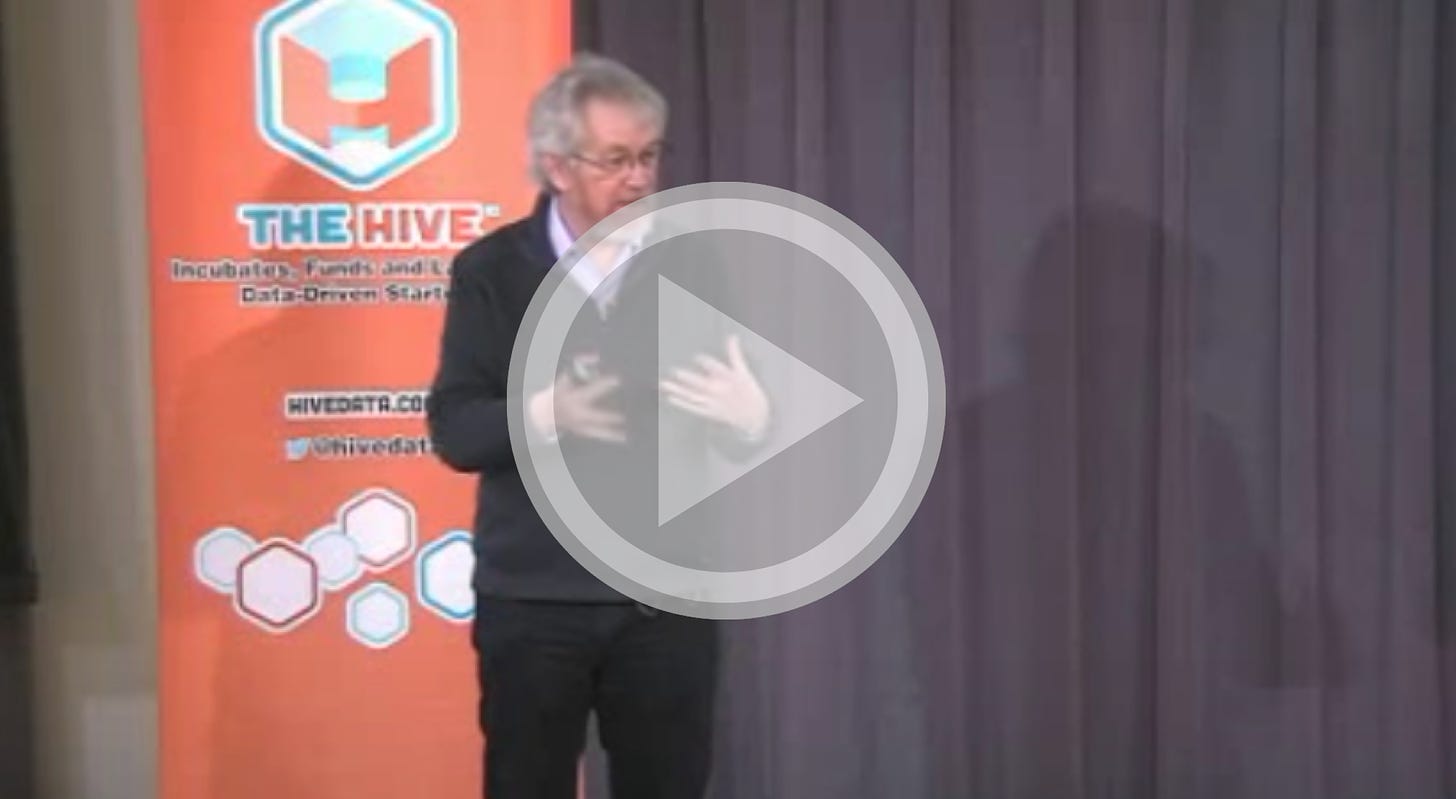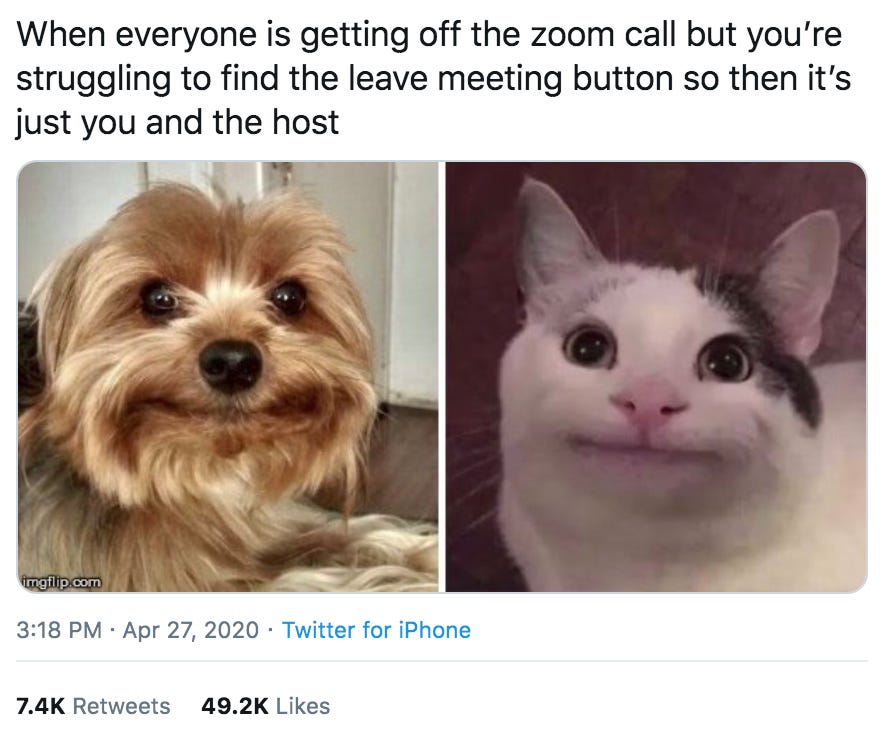“The reason why meetings often don’t work is because the boss is there”
Subscribe to receive this in your inbox
Previously on Make Work Better: we’re in this new form of working for the long-term. Companies have already started their exit strategy from having big expensive office space to some sort of remote/coworking hybrid. It means that anyone interested in creating successful winning work culture needs to start building it now.
Last week I talked about the importance of firms empowering workers’ autonomy right now if we’re going to transition to a new way of working. Today I wanted to share what we’re going to miss from the office if we don’t plan ahead.
I was on Radio 4’s Today programme last Monday with Lucy Kellaway, and mentioned the person who told me that his firm had gone from 1400 people coming into the office every day, down to 30. To paraphrase his comment to me: ‘Anyone who thinks we’re going back to the old world is bananas’. Let’s do some very rough maths. A desk in central London (with the other costs of the building) sets a firm back about £500 per month, £6000 per year. For, say, 1400 people that’s annual rent of £8m. (For firms with showy offices these numbers are significantly higher).
If the firm switches to hot desks for 100 people the cost immediately drops by over £7.5m. A pretty handy saving in the middle of the biggest depression since the 1930s.
Across the country firms will be doing this calculation. On the Radio 4 piece I said I expected when it came to it, as an example, Sir Martin Sorrell (annual rent £35m) would bank the money he’s talked about freeing up. He took exception to this: yes, he’s planning to slash his rent bill; no, he’s going to switch it to wages rather than his bank account.
Of course, this raises questions. If everyone is remote and maybe over time they aren’t expected to come into the office at all, then, erm, couldn’t we be remote from, say, India?

The challenge seems to be for us to demonstrate that we can make remote work very effectively, and build cohesive and inventive team cultures before another wave of disruption hits us.
Two of the big considerations of moving to the new world are: harnessing the power of more autonomy and replacing the magic of serendipity. Taking them both in turn.
Autonomy
I saw a quote from a McKinsey post last week: “As companies adopt new ways of working at speed and at scale, three lessons are emerging: a vindication for flatter, faster, nonhierarchical structures and approaches; the need to turbocharge decision making; and a reminder of the role of talent in making everything go”. If you can get rid of red tape and bureaucracy, firms can move faster.
One question that any boss might be thinking about is: what is our rate of (cognitive) taxation?
In other words, of the 8 (?) hours you’ve contracted your team to work every day, how much are you committing them to do before they can start making decisions themselves. Before the lockdown the average office worker was spending 16 hours a week in meetings. That’s 2 days a week. 16 hours of a working week of 40 hours is a cognitive tax of 40% just for meetings.
How long do you spend on emails? It’s easy right now to understand your job to be just doing emails. I’m pretty certain, and it deserves repeating for the people at the back that ‘emails are not your job’. Emails are a tool to help you with your job.
The critical thing here for firms is allowing workers to make more decisions. Giving them more leverage to make quick calls on things. Is your firm freeing people from video calls and allowing them to do a job that they can see they’re making progress in?
Serendipity – a mind-blowing research finding
One of the things that anyone who loved office life is going to miss is the sense that chance encounters added colour to the day. A look at the evidence suggests that quick spontaneous chats with people are more than just enjoyable, they are one of the driving forces for creative ideas at work. Professor Sandy Pentland has been pioneering in this area. (I talked about his work with excitement here). Pentland was able to observe how the things that we think drive workplace productivity – meetings, emails, instant messaging – have very little impact on what actually gets done.

(Essential clip: watch Pentland here talking about how face-to-face conversation is the secret superpower of the office).
“Most of this is not in meetings”
If you watch for 2 or 3 minutes on that clip, Pentland gives a compelling additional detail. The reason why meetings often don’t work is because the boss is there. People can’t talk openly about their ideas when the boss is shaking his head or saying ‘we’ve tried it before’.
‘For creative groups it’s the amount they talk to other people that they’re ‘not supposed to’ that predicts their creative output’.
Wow. Hang on. But if we’re getting rid of casual communication and corridor chatter then… won’t… we… feel the loss of this secret contribution? Yes. It makes it more important than ever that you lower the cognitive taxation of your team. Free them up from Zoom calls.
The company that sprung out of Pentland’s work used their badges to track interactions between workers in real workplaces. The chart below shows the pattern of interactions for 3 different branches of the same company. Each dot is a person, each line is their interactions with other colleagues. A thicker line is more communication.
Branch 1 had the highest productivity. In this branch there was a bonus scheme that incentivised everyone to share. Branch 2 had a rather different pattern of communication. Any idea why Branch 2 had two different clusters of interactions? The left-hand side was the first floor of their office, the right-hand side was the second floor. Branch 3 looked a little like Branch 1 with a few outliers. The outliers were new starters (generally with over a month’s tenure but still not integrated into the team).

More: Read/Listen to Professor Pentland / more on the MIT research
I read something intriguing last week relevant to this. It was about the role of chaos as a force for creativity. Science writer Lulu Miller was describing how accidents and mistakes are often the route to unexpected innovations.
“chaos is also the force that makes growth, and throws out a shooting star, and the rainbow, and the things that are the surprises you can’t even think to dream up”.
Pentland’s talk backs this up. He mentions that when innovations happen at work it is generally when teams who weren’t meant to work together get together to fuse ideas. It’s chaos rather than planning that creates special moments.
It begs the question what can we do to give our cultures the impact of corridor conversations, backchannels and a degree of randomness? Regular meet-ups in person, social meetings and giving people space to think seem to be vital.


Read: 2/3 of employers say it’s been hard to maintain company culture during the pandemic
Read: Leaders who don’t believe rules apply to them destroy organisations from the inside: “When the person at the top is malignant and self-serving, unethical behaviour cascades through the organisation and becomes legitimised”
Read: Here we go, more new tech solutions to pretend to fix the void in our lives. A virtual watercooler to chat with colleagues, something in VR/AR from Facebook (Occulus I’m guessing but the tweeter doesn’t really specify)
Read: Enthusiasm is worth 25 points of IQ (caveat, the source is the author’s opinion)
New Eat Sleep Work Repeat podcast: two members of West Midlands Fire talk about stress at work and when it’s ok to say you’re not ok (also April Vellacot and Jez Groom talk behavioural nudges at work)
Read: I’ve name-checked WordPress/Automattic a couple of times. Their CEO has a blog detailing the stages of remote working here
More from Bruce: The Joy of Work (UK), Eat Sleep Work Repeat (US), the podcast.










